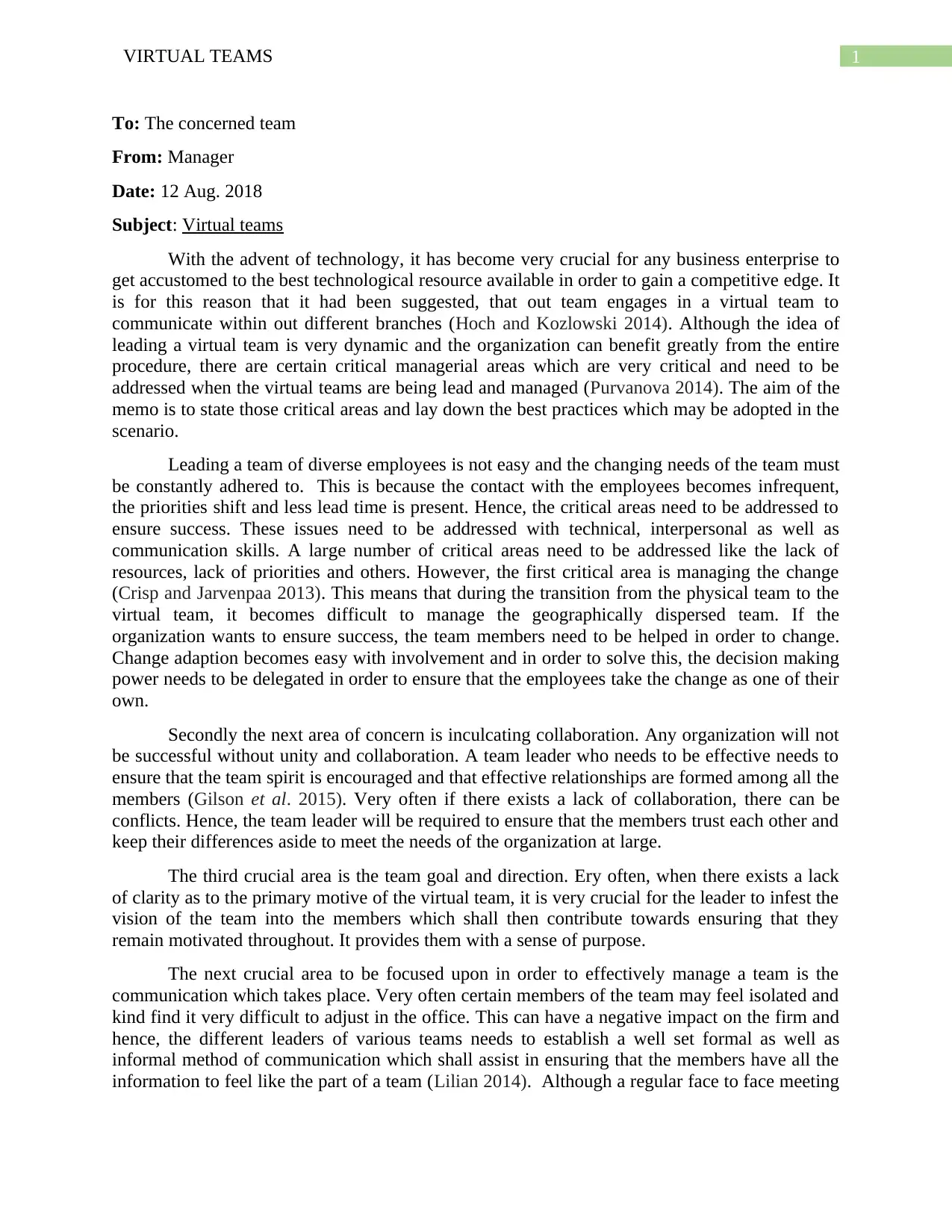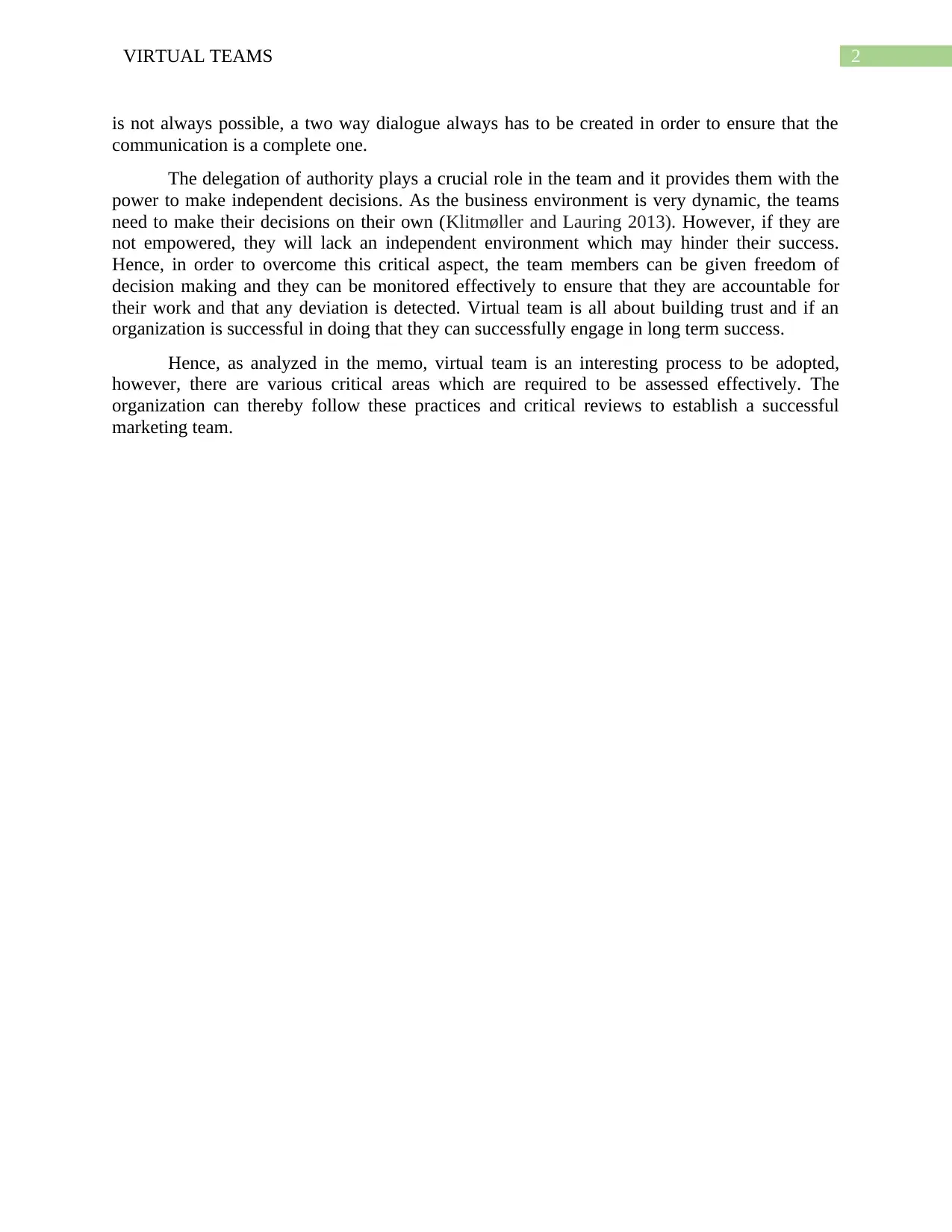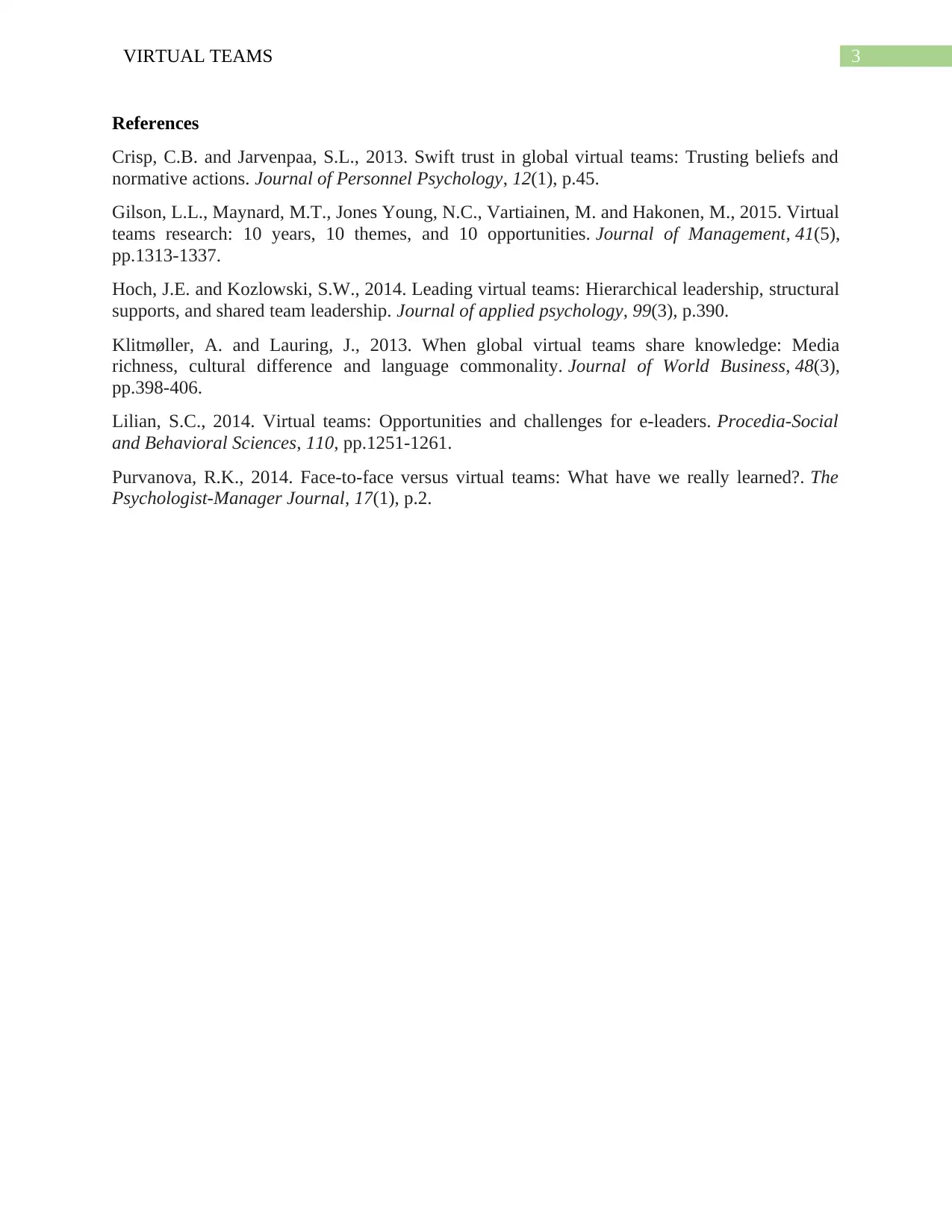Managing Virtual Teams: Critical Areas & Best Practices - MNG81001
VerifiedAdded on 2023/06/08
|4
|1080
|208
Report
AI Summary
This memo addresses the critical managerial areas in leading and managing virtual teams, emphasizing the importance of adapting to technological advancements for competitive advantage. It highlights key challenges such as managing change during the transition from physical to virtual teams, fostering collaboration among geographically dispersed members, ensuring clarity in team goals and direction, establishing effective communication channels, and delegating authority to empower team members. The memo stresses the significance of building trust within the virtual team to achieve long-term success, suggesting that by addressing these critical areas and implementing the recommended practices, organizations can effectively manage their virtual teams and achieve their objectives.

Running head: VIRTUAL TEAMS
VIRTUAL TEAMS
Name of the Student
Name of the University
Author Note
VIRTUAL TEAMS
Name of the Student
Name of the University
Author Note
Paraphrase This Document
Need a fresh take? Get an instant paraphrase of this document with our AI Paraphraser

1VIRTUAL TEAMS
To: The concerned team
From: Manager
Date: 12 Aug. 2018
Subject: Virtual teams
With the advent of technology, it has become very crucial for any business enterprise to
get accustomed to the best technological resource available in order to gain a competitive edge. It
is for this reason that it had been suggested, that out team engages in a virtual team to
communicate within out different branches (Hoch and Kozlowski 2014). Although the idea of
leading a virtual team is very dynamic and the organization can benefit greatly from the entire
procedure, there are certain critical managerial areas which are very critical and need to be
addressed when the virtual teams are being lead and managed (Purvanova 2014). The aim of the
memo is to state those critical areas and lay down the best practices which may be adopted in the
scenario.
Leading a team of diverse employees is not easy and the changing needs of the team must
be constantly adhered to. This is because the contact with the employees becomes infrequent,
the priorities shift and less lead time is present. Hence, the critical areas need to be addressed to
ensure success. These issues need to be addressed with technical, interpersonal as well as
communication skills. A large number of critical areas need to be addressed like the lack of
resources, lack of priorities and others. However, the first critical area is managing the change
(Crisp and Jarvenpaa 2013). This means that during the transition from the physical team to the
virtual team, it becomes difficult to manage the geographically dispersed team. If the
organization wants to ensure success, the team members need to be helped in order to change.
Change adaption becomes easy with involvement and in order to solve this, the decision making
power needs to be delegated in order to ensure that the employees take the change as one of their
own.
Secondly the next area of concern is inculcating collaboration. Any organization will not
be successful without unity and collaboration. A team leader who needs to be effective needs to
ensure that the team spirit is encouraged and that effective relationships are formed among all the
members (Gilson et al. 2015). Very often if there exists a lack of collaboration, there can be
conflicts. Hence, the team leader will be required to ensure that the members trust each other and
keep their differences aside to meet the needs of the organization at large.
The third crucial area is the team goal and direction. Ery often, when there exists a lack
of clarity as to the primary motive of the virtual team, it is very crucial for the leader to infest the
vision of the team into the members which shall then contribute towards ensuring that they
remain motivated throughout. It provides them with a sense of purpose.
The next crucial area to be focused upon in order to effectively manage a team is the
communication which takes place. Very often certain members of the team may feel isolated and
kind find it very difficult to adjust in the office. This can have a negative impact on the firm and
hence, the different leaders of various teams needs to establish a well set formal as well as
informal method of communication which shall assist in ensuring that the members have all the
information to feel like the part of a team (Lilian 2014). Although a regular face to face meeting
To: The concerned team
From: Manager
Date: 12 Aug. 2018
Subject: Virtual teams
With the advent of technology, it has become very crucial for any business enterprise to
get accustomed to the best technological resource available in order to gain a competitive edge. It
is for this reason that it had been suggested, that out team engages in a virtual team to
communicate within out different branches (Hoch and Kozlowski 2014). Although the idea of
leading a virtual team is very dynamic and the organization can benefit greatly from the entire
procedure, there are certain critical managerial areas which are very critical and need to be
addressed when the virtual teams are being lead and managed (Purvanova 2014). The aim of the
memo is to state those critical areas and lay down the best practices which may be adopted in the
scenario.
Leading a team of diverse employees is not easy and the changing needs of the team must
be constantly adhered to. This is because the contact with the employees becomes infrequent,
the priorities shift and less lead time is present. Hence, the critical areas need to be addressed to
ensure success. These issues need to be addressed with technical, interpersonal as well as
communication skills. A large number of critical areas need to be addressed like the lack of
resources, lack of priorities and others. However, the first critical area is managing the change
(Crisp and Jarvenpaa 2013). This means that during the transition from the physical team to the
virtual team, it becomes difficult to manage the geographically dispersed team. If the
organization wants to ensure success, the team members need to be helped in order to change.
Change adaption becomes easy with involvement and in order to solve this, the decision making
power needs to be delegated in order to ensure that the employees take the change as one of their
own.
Secondly the next area of concern is inculcating collaboration. Any organization will not
be successful without unity and collaboration. A team leader who needs to be effective needs to
ensure that the team spirit is encouraged and that effective relationships are formed among all the
members (Gilson et al. 2015). Very often if there exists a lack of collaboration, there can be
conflicts. Hence, the team leader will be required to ensure that the members trust each other and
keep their differences aside to meet the needs of the organization at large.
The third crucial area is the team goal and direction. Ery often, when there exists a lack
of clarity as to the primary motive of the virtual team, it is very crucial for the leader to infest the
vision of the team into the members which shall then contribute towards ensuring that they
remain motivated throughout. It provides them with a sense of purpose.
The next crucial area to be focused upon in order to effectively manage a team is the
communication which takes place. Very often certain members of the team may feel isolated and
kind find it very difficult to adjust in the office. This can have a negative impact on the firm and
hence, the different leaders of various teams needs to establish a well set formal as well as
informal method of communication which shall assist in ensuring that the members have all the
information to feel like the part of a team (Lilian 2014). Although a regular face to face meeting

2VIRTUAL TEAMS
is not always possible, a two way dialogue always has to be created in order to ensure that the
communication is a complete one.
The delegation of authority plays a crucial role in the team and it provides them with the
power to make independent decisions. As the business environment is very dynamic, the teams
need to make their decisions on their own (Klitmøller and Lauring 2013). However, if they are
not empowered, they will lack an independent environment which may hinder their success.
Hence, in order to overcome this critical aspect, the team members can be given freedom of
decision making and they can be monitored effectively to ensure that they are accountable for
their work and that any deviation is detected. Virtual team is all about building trust and if an
organization is successful in doing that they can successfully engage in long term success.
Hence, as analyzed in the memo, virtual team is an interesting process to be adopted,
however, there are various critical areas which are required to be assessed effectively. The
organization can thereby follow these practices and critical reviews to establish a successful
marketing team.
is not always possible, a two way dialogue always has to be created in order to ensure that the
communication is a complete one.
The delegation of authority plays a crucial role in the team and it provides them with the
power to make independent decisions. As the business environment is very dynamic, the teams
need to make their decisions on their own (Klitmøller and Lauring 2013). However, if they are
not empowered, they will lack an independent environment which may hinder their success.
Hence, in order to overcome this critical aspect, the team members can be given freedom of
decision making and they can be monitored effectively to ensure that they are accountable for
their work and that any deviation is detected. Virtual team is all about building trust and if an
organization is successful in doing that they can successfully engage in long term success.
Hence, as analyzed in the memo, virtual team is an interesting process to be adopted,
however, there are various critical areas which are required to be assessed effectively. The
organization can thereby follow these practices and critical reviews to establish a successful
marketing team.
⊘ This is a preview!⊘
Do you want full access?
Subscribe today to unlock all pages.

Trusted by 1+ million students worldwide

3VIRTUAL TEAMS
References
Crisp, C.B. and Jarvenpaa, S.L., 2013. Swift trust in global virtual teams: Trusting beliefs and
normative actions. Journal of Personnel Psychology, 12(1), p.45.
Gilson, L.L., Maynard, M.T., Jones Young, N.C., Vartiainen, M. and Hakonen, M., 2015. Virtual
teams research: 10 years, 10 themes, and 10 opportunities. Journal of Management, 41(5),
pp.1313-1337.
Hoch, J.E. and Kozlowski, S.W., 2014. Leading virtual teams: Hierarchical leadership, structural
supports, and shared team leadership. Journal of applied psychology, 99(3), p.390.
Klitmøller, A. and Lauring, J., 2013. When global virtual teams share knowledge: Media
richness, cultural difference and language commonality. Journal of World Business, 48(3),
pp.398-406.
Lilian, S.C., 2014. Virtual teams: Opportunities and challenges for e-leaders. Procedia-Social
and Behavioral Sciences, 110, pp.1251-1261.
Purvanova, R.K., 2014. Face-to-face versus virtual teams: What have we really learned?. The
Psychologist-Manager Journal, 17(1), p.2.
References
Crisp, C.B. and Jarvenpaa, S.L., 2013. Swift trust in global virtual teams: Trusting beliefs and
normative actions. Journal of Personnel Psychology, 12(1), p.45.
Gilson, L.L., Maynard, M.T., Jones Young, N.C., Vartiainen, M. and Hakonen, M., 2015. Virtual
teams research: 10 years, 10 themes, and 10 opportunities. Journal of Management, 41(5),
pp.1313-1337.
Hoch, J.E. and Kozlowski, S.W., 2014. Leading virtual teams: Hierarchical leadership, structural
supports, and shared team leadership. Journal of applied psychology, 99(3), p.390.
Klitmøller, A. and Lauring, J., 2013. When global virtual teams share knowledge: Media
richness, cultural difference and language commonality. Journal of World Business, 48(3),
pp.398-406.
Lilian, S.C., 2014. Virtual teams: Opportunities and challenges for e-leaders. Procedia-Social
and Behavioral Sciences, 110, pp.1251-1261.
Purvanova, R.K., 2014. Face-to-face versus virtual teams: What have we really learned?. The
Psychologist-Manager Journal, 17(1), p.2.
1 out of 4
Related Documents
Your All-in-One AI-Powered Toolkit for Academic Success.
+13062052269
info@desklib.com
Available 24*7 on WhatsApp / Email
![[object Object]](/_next/static/media/star-bottom.7253800d.svg)
Unlock your academic potential
Copyright © 2020–2025 A2Z Services. All Rights Reserved. Developed and managed by ZUCOL.



